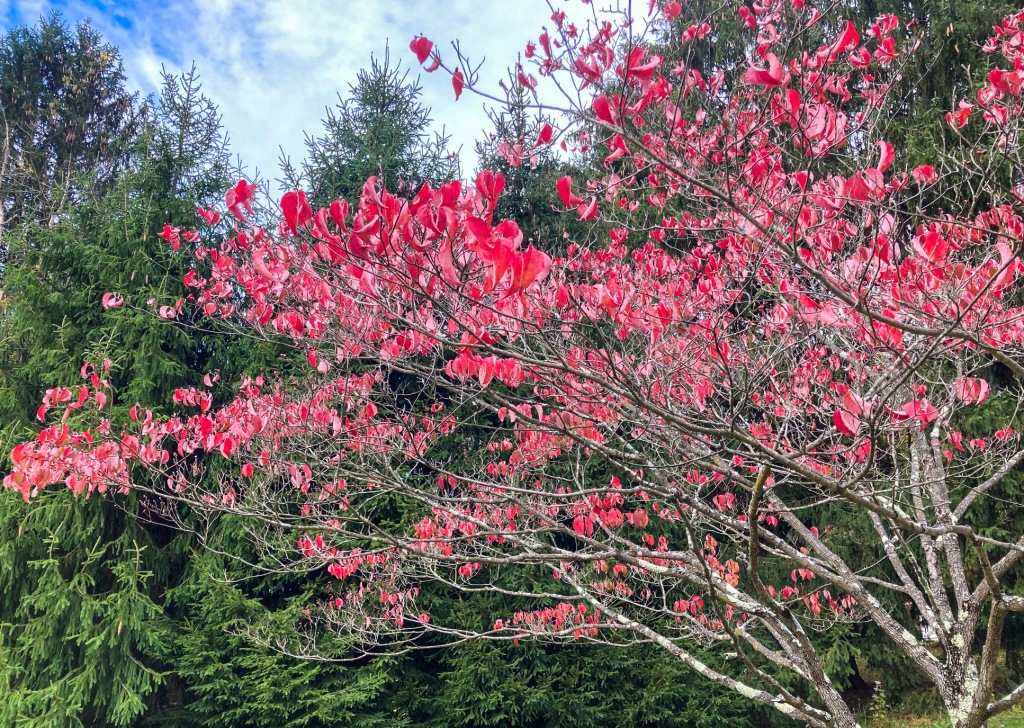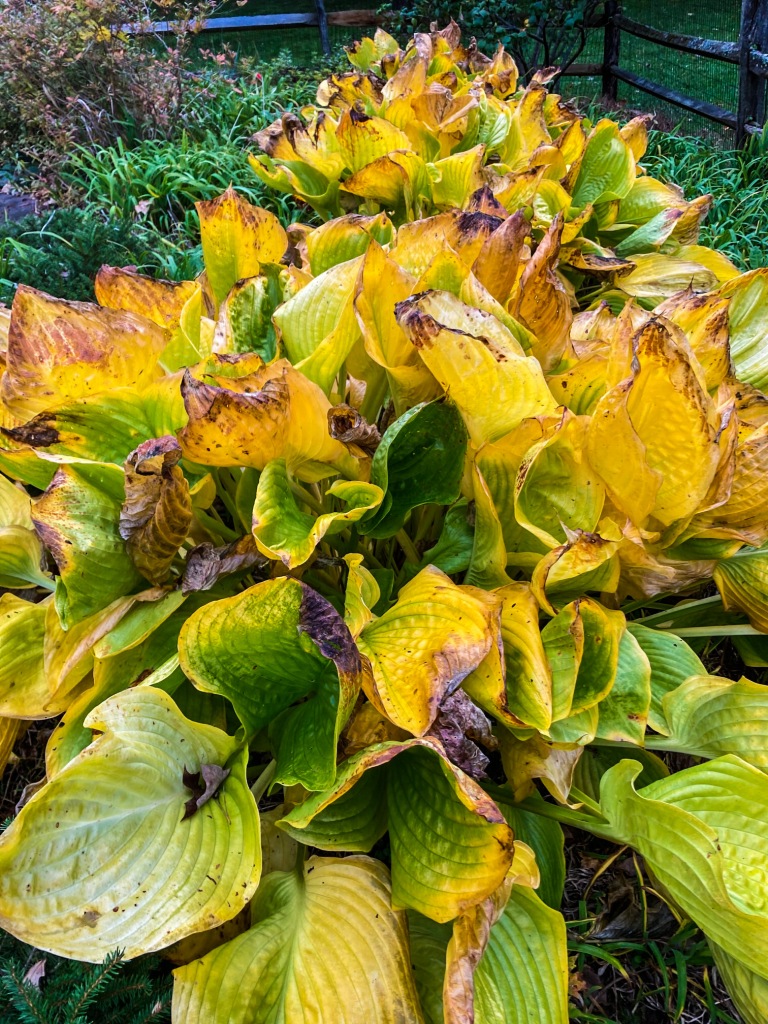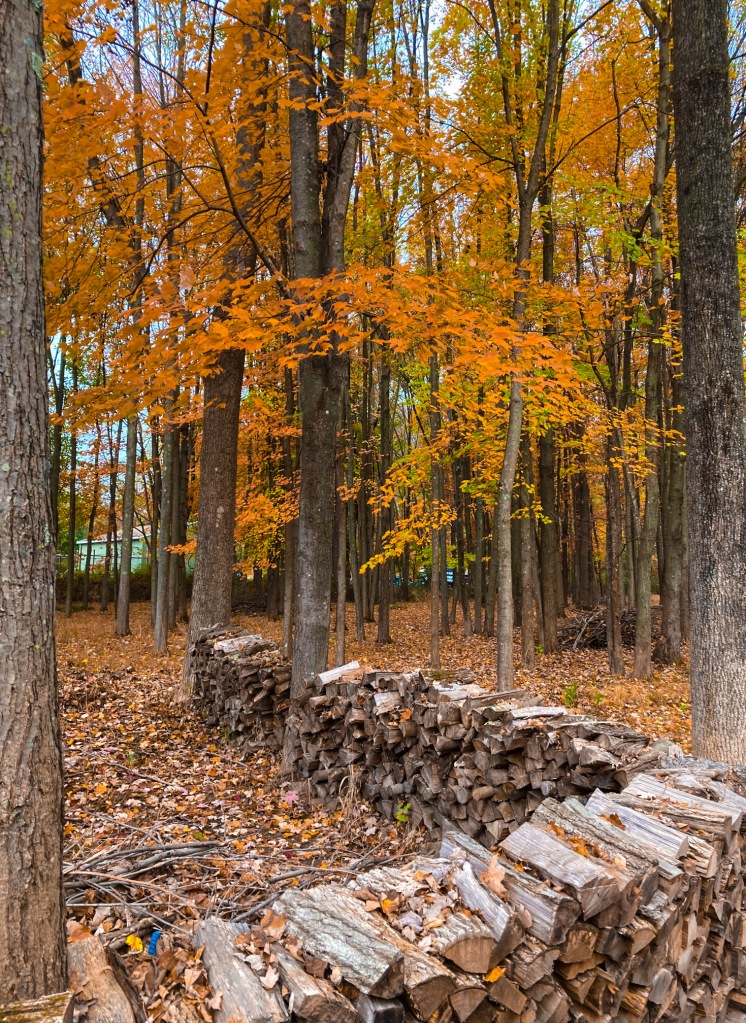October has been a peculiar month in northwestern New Jersey. The temperature never dropped below 40, and abundant rain from Hurricane Ida and two nor’easters worked to create the best fall colors we’ve seen in years. I grew up in New England where I took for granted fall colors in brilliant hues with reds that took your breath away. In New Jersey, not so much. Yellows and browns mainly, with a blush of rouge.
This morning I could hear squirrels crunching through a carpet of leaves and, although the woods were just past their prime, there were enough leaves struggling to hold their grips to fill the woods with a last hurrah of color.
Although the long-range view is wonderful, you need to get close to absorb the kaleidoscopic pastels and arrogant primary colors, something to hold on to when the wind chills your cheeks and snow shows deer and fox tracks.
Here’s this morning’s remembrance of woods and garden bedding down.

Dogwood 
Hosta 
Hydrangea 
Colors 
Red Maple 
Rose – fresh & faded
Unfortunately, bedding down is not something that just happens. Human intervention is involved. Aside from raking, mulching, and light pruning, we should do other things to get ready for winter. This made me think of an advice column written by Bitsy Crangle, a character I invented for Master Gardener, a novel published a few years ago. I conceived of Bitsy as a busy body know-it-all master gardener who irritated my main character by continually pointing out how little he knew about gardening
But, in the unexplored and confused mind of this author, I got to like her deadly, and she turned into one of the book’s heroines. It’s one of those situations where your character simply takes over. Each chapter of the book begins with the gardening column Bitsy writes for the local paper in Middletown, New Anglia (which is one of those little-known states in New England). This is one she wrote for October:
Mastering your Garden
By Elizabeth Pendleton Crangle
Picky, picky, picky! Many of you argued that Zucchini is a fruit and it should have been my “Z” for last month. I think that is still open to argument, but one reader explained that the Zinfandel grape is a fruit, so I sit (I don’t stand while writing) corrected. I used to teach school, and it’s nice to know you are paying attention.
We can expect the first touch of frost this month, and you might want to extend the color and life of your annuals by covering them with a sheet or tarp on evenings when frost is expected. This is also the time to gather completely dried seedpods, collect the seeds, put them in a sealed container and refrigerate. Why pay the big seed companies their ever-increasing prices when your seeds are free? I especially encourage you to harvest Asclepias (milkweed family) seeds to plant next year. The monarch butterflies love and need those plants.
This is also the month to give new plantings and container plants plenty of water. With cooler weather, we don’t notice how dry it gets, but the plants do. The good news is that you probably will not have to water again until spring. Along those lines, you may still plant trees and shrubs now. Once watered in and dormancy sets in, they will begin to establish themselves over the winter and get a good start next spring.
Apples! They are so good and so many varieties of them are available at farm stands and markets now. Last year I bought a little apple-peeling machine that saved me hours of work. Look for the ones that core and peel apples by turning a crank. If you know how to use the www web, you can learn how to make applejack from the peelings. Strictly for medicinal purposes, of course.
Chances are fall rains will saturate the soil around your home, making weed control a bit easier. Perennial weeds will only become more of a nuisance next year so remove them (such as thistle, dandelion, dock, Japanese knotweed and plantain) with an appropriate tool and try to get all the roots. Mulch your garden heavily with an organic mulch (I’ve had success with well-rotted horse manure) to thwart winter weeds and protect perennials from freezing and thawing.
I have a friend who can’t wait for the first frost to harvest rose hips for tea and jelly. He breaks off the stems and spreads them out on newspapers (he says the Courier-Times works best) to dry. When they begin to shrivel, he removes the seeds and lets them dry completely. He stores them in sealed plastic containers and crushes a teaspoon full to make one cup of tea. With honey, it’s summer all over again.
In my garden, I have many berry plants to help feed birds over the winter, and I also put out suet and seeds, especially in early spring when food for them is scarce. I’ve discovered some of them love peanut butter, which I now buy in bulk from a wholesale warehouse. What we tend to forget is that birds need water over the winter too. There are heaters for birdbaths that keep them from freezing. Also, place a pile or two of brush around the yard so the little birds can find shelter from predators.
As you can see, there is plenty to do in the garden in October. Resist the idea of putting it off until November. As you will see next month, a garden and a gardener never really rest!
Blissful gardening – Bitsy
If you’d like to read more about Bitsy, go to

After exploring a few of the blog posts on your blog, I truly like your way of blogging. I added it to my bookmark webpage list and will be checking back in the near future. Please check out my web site too and let me know how you feel.
LikeLike
This site truly has all the information I needed about this subject and didn’t know who to ask.
LikeLike
Good post. I learn something new and challenging on websites I stumbleupon on a daily basis. It’s always exciting to read content from other authors and practice a little something from other sites.
LikeLike